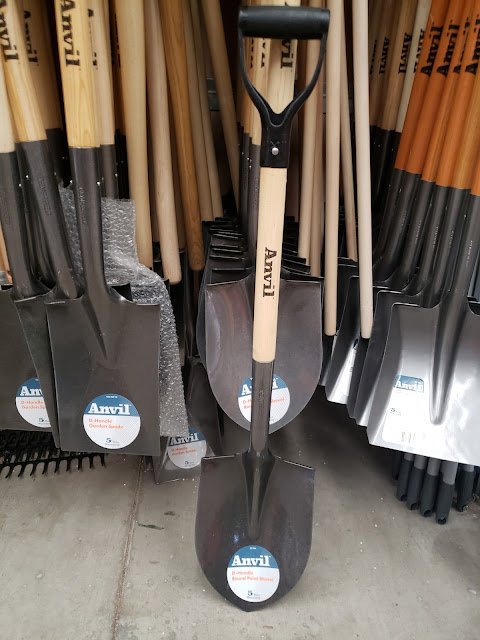The dust has settled and the First 72 Hours have passed. Follow along as I build a long term plan via Prudent Prepping.
I was asked by our illustrious Editrix to write a post on digging implements, and not just my ability to write myself into a hole and never get out.
... Isn't Necessarily a Shovel
And it may not 'dig' as well as you would like, either. In fact, there's something on this list that digs quite well and in no way is shovel. Let's get started.
What's The Difference?
More than you might think. While everything can be used to scoop or pick up material, some designs are better suited to the job. A snow shovel could be used to move gravel, but the operator won't last too long. The American Heritage Dictionary defines a shovel as a tool with a handle and a broad scoop or blade for digging and moving material, such as dirt or snow.
However, it also defines a spade as a sturdy digging tool having a thick handle and a heavy, flat blade that can be pressed into the ground with the foot. So by definition, shovels have a scoop (curved) blade and spades are flat... sometimes. I'll explain by showing some examples. I am mostly using pictures and descriptions from Home Depot, but tools are available everywhere.
The Anvil garden spade is designed to be used in confined areas between vegetables and closely planted flowers. It is a great tool for transplanting perennials. The 28 in. hardwood handle with poly D-grip and steel open-back blade will allow the user to work effectively in confined areas.
This shovel is of good quality. It is designed for light-duty jobs around the lawn and garden. It features a "D" style grip for secure handling.
There are two types of these shovels. This is the slightly heavier version, with a turned over lip for using your foot to generate more force to did in harder ground.
Now, this looks a little confusing, since it has a square end, but with the curved sides it qualifies as a shovel. Really!
Ideal for lifting and moving loads of rock, soil and other materials. Designed to transport loose material, such as soil, sand and gravel. This shovel features a square, coated blade with a 20 in. wooden handle. The D-shaped grip is large enough for a gloved hand.
Other Types of Digging Tools
Very similar to a pitchfork, a spading fork has fewer and much heavier tines, with a heavy back to allow using your foot to generate extra force when digging in dense soil.
The Razor-Back spading fork is a multipurpose tool that can be used for turning, digging and loosening all types of soil. It can also be used to transfer loose material. The forged head is made for maximum strength and durability.
This is another digging tool familiar to many former military members. While not exactly a government issue shovel, it is close enough to bring back bad memories of sore backs to those I asked about its use.
 | |
| Redcamp Folding Shovel |
This isn't a spade or a shovel, but it was a gift that I mentioned in this blog post, quite a while ago. Well, the manufacturer calls it a shovel, but in reality it is the same size as a gardening trowel.
 | |
| UST Folding Shovel |
I have it in my camping gear, which is in storage, otherwise I'd use a picture of my own. I have used it to dig very small holes in fluffy, rock-less soil and it worked great. I wasn't expecting it to work as well as it did.
When Do I Use What?
So, to sort of make things clear:
- Spades (or spading forks) are designed to loosen soil.
- Shovels are intended to dig soil and or scoop material, with the obvious overlap mentioned above.
- A folding camp shovel, very similar to the military issue entrenching tool, is a compact, lightweight compromise tool when weight and overall size is the primary requirement.
- A folding trowel is not to be used for anything but very light digging in fairly light soil.
Recap and Takeaway
- If I was still doing backcountry hiking, I would need a shovel like the Redcamp for larger digging, and I would still take the UST trowel too.
- As with everything in prepping, spend your money wisely and buy what you need when you can. Also, be prepared to upgrade, also when you can.
* * *
Just a reminder: if you plan on buying anything through Amazon, please consider using our referral link. When you do, a portion of the sale comes back here to help keep this site running!
If you have comments, suggestions or corrections, please post them so we all can learn. And remember, Some Is Always Better Than None!
NOTE: All items tested were purchased by me. No products have been loaned in exchange for a favorable review. Any items sent to me for T&E will be listed as such. Suck it Feds.






I've dug a lot of (civilian) holes with the folding USGI shovels. It's a pretty cool piece of design and engineering. Great article.
ReplyDelete